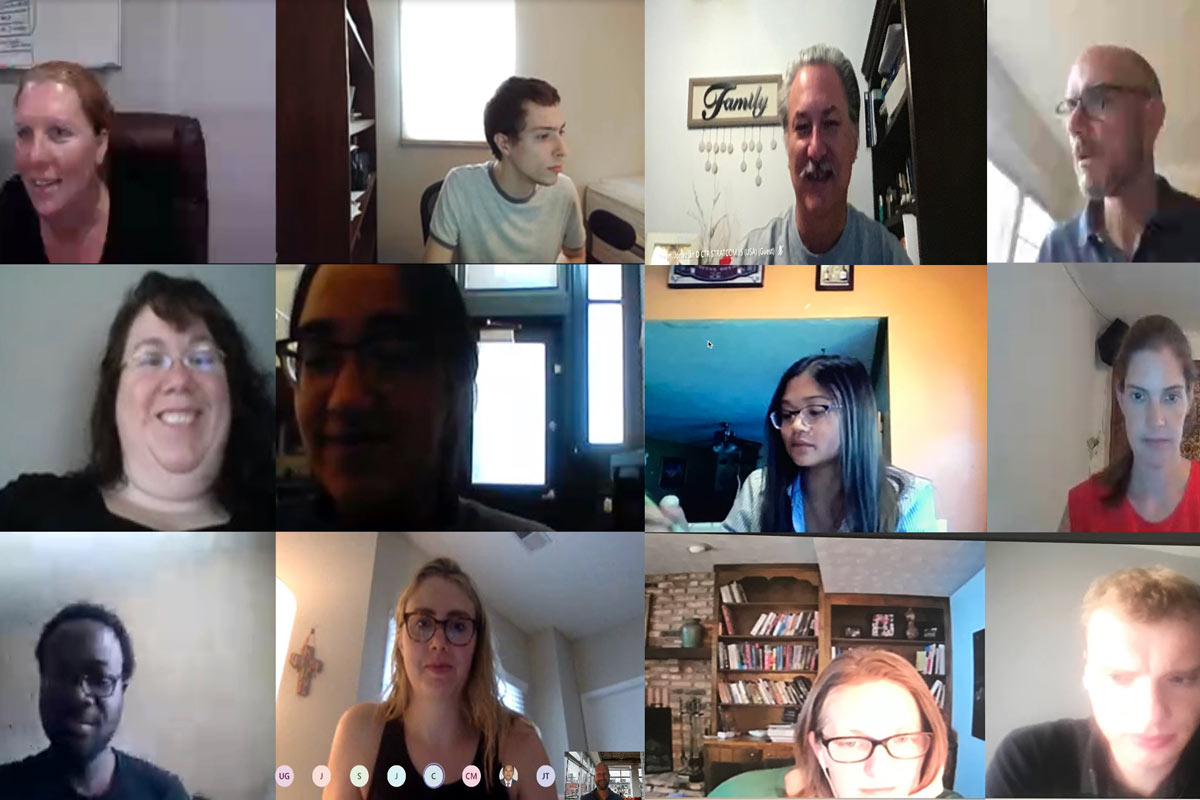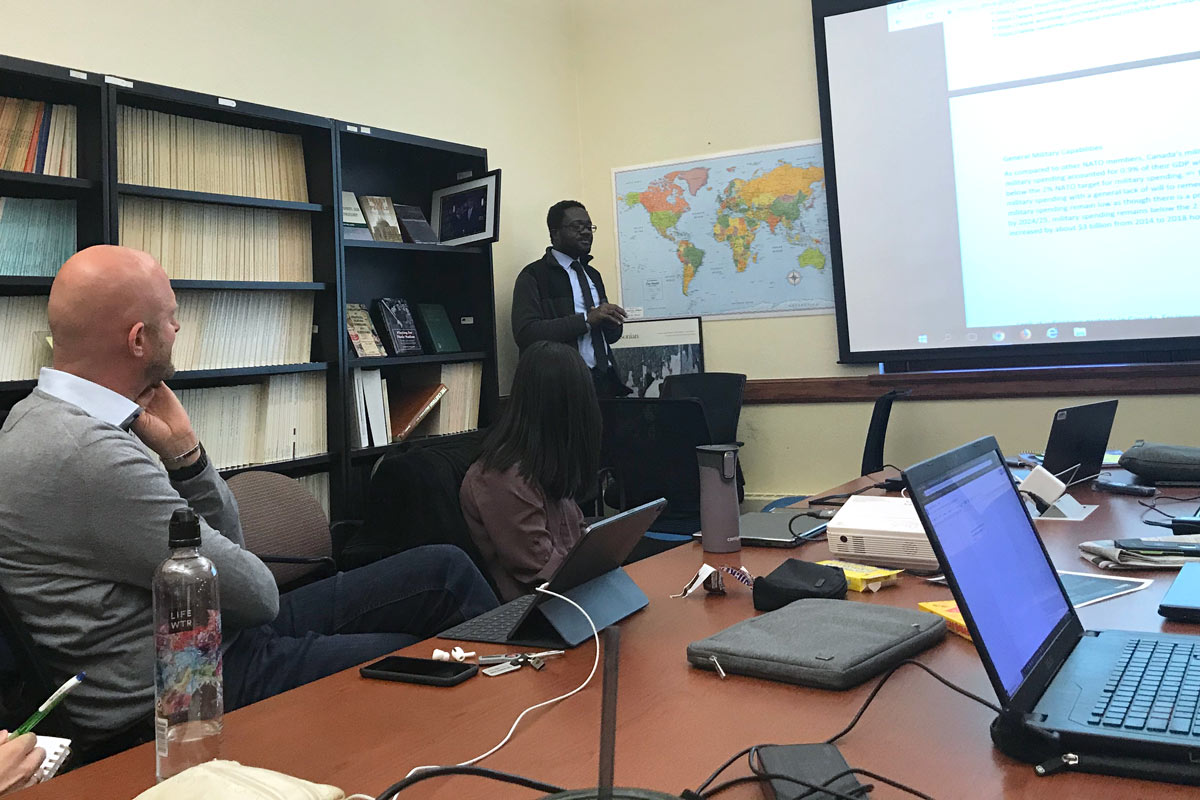NATO-funded Project Explores New Deterrence Methodology
- contact: Courtni Kopietz - College of Arts and Sciences

Over the last year, Michelle Black, Ph.D., an assistant professor of political science at UNO, led a team of eight undergraduate and graduate students in testing a new multi-actor deterrence methodology in collaboration with NATO. The project, enabled by a NATO research grant, was meant to elucidate implications for alliance decision making and adaptation to new and emerging security challenges.
The student researchers included:
• Liz Armenta
• Liz Bender
• Ebenezer Koomson
• Aaron Kurtzman
• Josie Nelson
• Maggie Reding
• Christopher Schneider
• Aya Yousuf
Research and Experimentation
The students were tasked with writing strategic profiles on nations that could be potential actors in the assigned, future-looking scenario. Using any publicly-accessible documents they could get their hands on, the students researched their assigned country’s identity politics, domestic politics, military capabilities, general history, and geopolitical relationships, to name a few. Some of the country profiles referenced upwards of 400 unique sources including books, news articles, scientific publications, and government security reports from the Department of Defense and the Defense Intelligence Agency.
These information-rich country profiles are then used in the methodology to essentially predict what actions different countries might take in a given scenario, decades into the future, and how those actions would then impact the roles and motivations of other nations.
“One of the biggest benefits in using this methodology is the ability to examine potential actors involved within a strategic competition or conflict," Black says. "Furthermore, this analysis can help NATO conduct continuous analysis and assessment to deepen their understanding of changing environments and adapt planning and operations accordingly to identified threats or compromising situations.”
While nothing can be predicted with 100 percent certainty, these insights could help countries make strategic decisions and anticipate emerging security challenges.
To date, deterrence analysis tends to use single-actor methodology, mostly because a multi-actor approach is so complex. But nothing happens in a vacuum—especially global politics—so a multi-actor approach to deterrence can offer a more robust analysis and more confidence in the results.
I liked that we were tackling something that hadn’t been done or tried before. It was an experimentation, both a new methodology and a new scenario that NATO had likely never talked about in-depth before.
“I liked that we were tackling something that hadn’t been done or tried before,” Kurtzman says. “It was an experimentation, both a new methodology and a new scenario that NATO had likely never talked about in-depth before.”
In October of 2019, Black and a few students participated in an initial experiment at the International Concept Development and Experimentation (ICD&E) Conference in Madrid, to test the initial framework of the methodology.
A final experiment was held virtually in early August of 2020 with the full team, along with NATO representatives and colleagues from United States Strategic Command (USSTRATCOM). Though the original plan was to have the final experiment in Brussels, the COVID-19 pandemic necessitated a pivot to a virtual format.
“Doing it online, it takes some getting used to, and everyone was definitely more quiet at first,” Kurtzman says. “But ultimately, I don't think it had that big of an effect on the experimentation itself. I think we would have come to the same conclusions if we had been in person.”
Ebenezer Koomson, a political science graduate student and graduate assistant, said he really enjoyed the final experiment and appreciated that it was able to still move forward virtually.
“The methodology that Dr. Black developed, it was brilliant, one of the best that I've ever been able to work with,” Koomson says. “It’s a little complex in the sense that there's a lot of moving parts that have to come together to create one thing, and that was challenging. But Dr. Black was so helpful and accessible, and she's still working with us to make sure we produce the very best thing that we can.”

“I learned how very complicated developing a decision calculus is,” Nelson says. “You have all this information, and it’s all important, seems important. But you have to pick and choose to make that final decision. Rating everything was eye-opening.”
In addition to the nuts and bolts of the project itself, collaborating with NATO representatives and meeting with professionals from STRATCOM elevated the student experience in many ways. The diverse group of representatives hailed from several different countries and offered cross-disciplinary perspectives to the discussions.
“Being able to go through the experiment with people who do this work for a living and seeing how they approach it was a really valuable experience,” says Christopher Schneider, a student on the project who recently earned his master’s degree in political science.
Maggie Reding, an undergraduate student studying political science and international studies echoed those sentiments. She, as well as many of the other students on the project, are interested in working in national security and global relations.
“Intelligence is something I’d like to go into, doing this kind of analyst work,” Reding says. “Working with these professionals who do this on a daily basis was a really cool experience. We have contacts and mentors to learn from, and overall the collaboration was a great experience.”
The project mostly concluded after the August experimentation, though some of the students are working to refine and put the finishing touches on their country profiles through the end of 2020. But while this phase of the research is done, Black says she hopes to continue building on the work.
“We are really only at the start of testing this methodology and I hope to continue this work with potential U.S. Department of Defense scenarios,” Black says. “I believe that expanding our view to include multiple actors, whether they be friendly or not, could really strengthen our understanding of future strategic competitions or conflicts.
My biggest lesson during this research project comes from how important it is to involve students and academia into military or defense projects. I think it is necessary to have a diverse team of participants involved, as it will only ensure things are being evaluated from multiple angles.”